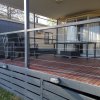Solar: Installation and Cost Considerations
Solar photovoltaic (PV) systems use panels to convert sunlight into electricity for your home. These roof panels consist of individual solar cells that convert sunlight into electricity for your home.
The cost of a PV system depends largely on the area, weight, and number and type of panels. Monocrystalline panels are made from single wafers of silicon and are usually more efficient,
while polycrystalline panels, which consist of cells fused together from silicon fragments, are usually less expensive.
A single-family home requires 15 to 34 solar panels to offset most of its energy consumption. The amount of sunlight on the roof affects the number of panels needed.
Panels cost between $2.40 and $3.60 per watt (including installation), so the more energy a PV system needs to produce, the higher the cost. On average,
a 6 kW PV system for a single-family home costs about $12,700 after federal tax credits.
Heather Laminack, an Austin custom home builder and remodeler, says customers often opt for solar panels once seasonal temperatures begin to rise.
“Now that we're in the middle of summer, it's peak electricity usage - people see electric bills, and electricity is really a significant factor in the total cost of homeownership,” Laminack said.
“A lot of times we think of the cost of homeownership as including the home, insurance and taxes, but utilities are a part of that as well.”
Utilizing Water-Saving Technology for Residential Electricity
A water-driven design approach is helping to drive sustainable development and home building in communities across the country. Total Hydrologic Planning is an approach that identifies and
utilizes all water resources on a project site. It uses strategies that best fit the relationship between the project's climate and site conditions to achieve a balance between site water supply and demand.
Such projects are more resilient to drought and storm events and prevent costly damage.
Water-saving fixtures (e.g., toilets, showerheads, and faucets) are among the most important environmental amenities. Combining these amenities with other water-centric strategies,
such as ENERGY STAR appliances and structural plumbing, can help save time and money on materials and labor, and can help homeowners save money on their utility bills.





